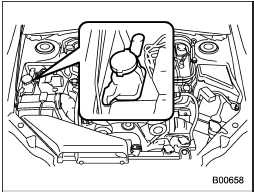Checking the fluid level

The power steering fluid expands greatly as its temperature rises; the fluid level differs according to fluid temperature.
Therefore, the reservoir tank has two different checking ranges for hot and cold fluids.
Check the power steering fluid level monthly.
1. Park the vehicle on a level surface, and stop the engine.

2. Check the fluid level of the reservoir tank.
When the fluid is hot after the vehicle has been run: Check that the oil level is between “HOT MIN” and “HOT MAX” on the surface of the reservoir tank.
When the fluid is cool before the vehicle is run: Check that the oil level is between “COLD MIN” and “COLD MAX” on the surface of the reservoir tank.
3. If the fluid level is lower than the applicable “MIN” line, add the recommended fluid as necessary to bring the level between the “MIN” and “MAX” line.
If the fluid level is extremely low, it may indicate possible leakage. Consult your SUBARU dealer for an inspection.

Be careful not to burn yourself because the fluid may be hot.

• When power steering fluid is being added, use only clean fluid, and be careful not to allow any dirt into the tank. And never use different brands together.
• Be careful not to spill power steering fluid when adding it. If power steering fluid touches the exhaust pipe, it may cause a bad smell, smoke, and/or a fire. If power steering fluid gets on the exhaust pipe, be sure to wipe it off.
See also:
Operating the driver’s window
1) Automatically open/close
2) Open/close
To open:
Press the switch down lightly and hold it. The window will open as long as the
switch is held.
This switch also has a one-touch auto down fun ...
Sounding a panic alarm
Sounding a panic alarm
A “PANIC” button is located on the back of the transmitter.
To activate the alarm, press the “PANIC” button once.
The horn will sound and the turn signal lights will flash.
...
Vehicle Dynamics Control system monitor
Refer to “Vehicle Dynamics Control operation indicator light” and “Vehicle Dynamics Control warning light/Vehicle Dynamics Control OFF indicator light/ Traction Control OFF indicator light (STI)”. ...


